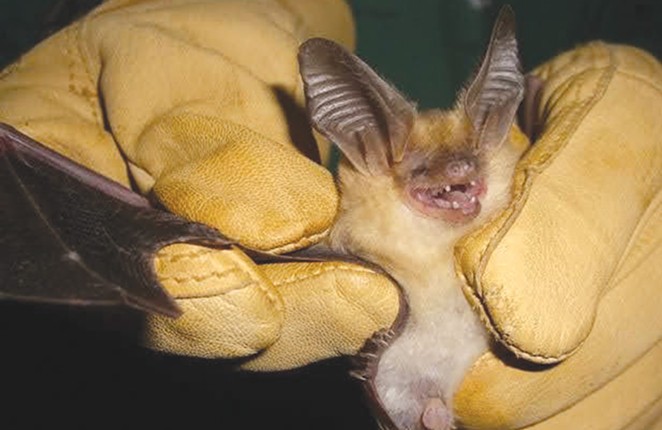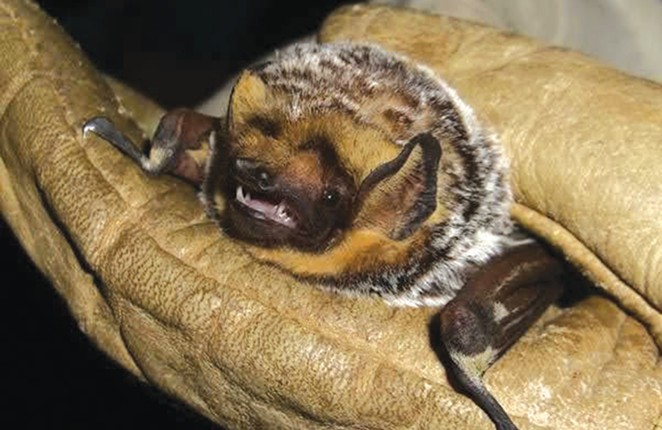Inspired by all things batty leading up to Halloween, chiropterologists ("studier of creature with winged hands") utilize the popularity of "spooky bats," vampires, Batman, and Batwoman with trick-or-treaters to inspire and educate people about real-life bats, proclaiming October to be Bat Appreciation Month. The last week of October is also Bat Week, an international celebration of all things batty.
Locally, Oregon State University-Cascades is home to the Northwest Bat Hub, a center for the coordination of resources and research by a collaboration of interagency partners to better understand the regional populations and issues associated with bat populations — especially the impacts of white-nosed syndrome, a deadly virus to bats which had been documented in the eastern U.S.
A bat-monitoring project using passive wildlife recorders was developed in Oregon and Washington mostly by the Forest Service, with Tom Rodhouse with the National Park Service helping to develop that project. "Tom realized a greater need for a centralized body to help guide everybody that wanted to contribute to this effort," said Sara Rose, assistant Bat Hub coordinator. "So, in 2016 the NPS and OSU got together to form the Northwest Bat Hub – a center of gravity for interagency collaboration for bat monitoring in the Pacific Northwest."
Additionally, the Audible Bat Project is a citizen-science endeavor that trains volunteers (and staff) to listen for audible bat sounds – basically the bats' echolocation calls as they navigate – which focuses on two primary species: Spotted bats and pallid bats; both are Oregon Conservation Strategy Species.
"This is a multi-state and multi-method approach which has citizen scientists that can go do individual surveys, or they can come out with me to do group surveys," added Rose. "We also have our field crews and agency partners doing surveys focused on these two species."
OSU-Cascades has also recently installed a Motus (Motus Wildlife Tracking System) tower atop Tykeson Hall. "These towers historically were installed to monitor the movement of birds," said Rose. That technology has found its way to bats; mist-netted bats have a tiny PIT tag (Passive Integrated Transponder) implanted between their shoulder blades. The tiny microchip activates as it passes by an antenna, which then records the time and tag number of the passing bat.
"People are using these more and more for bats, so we have our one tower here, but Oregon is hoping to build a network of these towers to track where bats are moving," added Rose.
For a long time, spotted bats were unknown in Oregon — until the 1970s. They have a low frequency echolocation call and fly high, compared to other bats in the region. These bats have pinkish, large ears, white bellies and white spots on a black back. "We've been learning through the Audible Bat Project that there are more spotted bats around than we originally thought," said Rose.
Both the spotted and pallid bats are vesper or nocturnal species. Whereas, spotted bats have small teeth and are relatively easy to handle, the pale-colored pallid bats have large sharp teeth that can bite through a leather glove. "Pallid bats specialize in eating larger insects and invertebrates, feeding on scorpions and grasshoppers by swooping down and grasping insects on the ground, which is their preferred method of hunting, and sometimes crawling on the ground," said Rose. Though the echolocations of pallid bats are difficult to hear, at maternity sites researchers have found that mother bats returning to their pups make unique social calls which are audible to humans; hence, enabling volunteers to locate these maternity colonies.
There are 15 species of bats in Oregon and all are insect or invertebrate eaters. Bats are also the only flying mammal; flying squirrels are gliders and not capable of true flight. In addition, bats roost in a variety of locations: caves, old barns, cliff faces and beneath the peeling bark on old-growth trees. Capable of speeds up to 20 to 30 mph, they dip and dive through the air using echolocation to locate prey. Hoary bats are one species that migrates south in winter.
"Bats absolutely perform critical ecosystem services that are of great monetary value to humans, but I don't like having to resort to that argument when advocating for bat conservation and bat-friendly management decisions," said Link Olson, University of Alaska Museum, curator of mammals, and former Madras resident who studied bats in the region. "Bats have their own incalculable intrinsic value, period. And they have an awful lot to teach us if we're smart enough to pay attention."
This Halloween, be aware of bats in your neighborhood, and not just the ones ringing your doorbell.

























